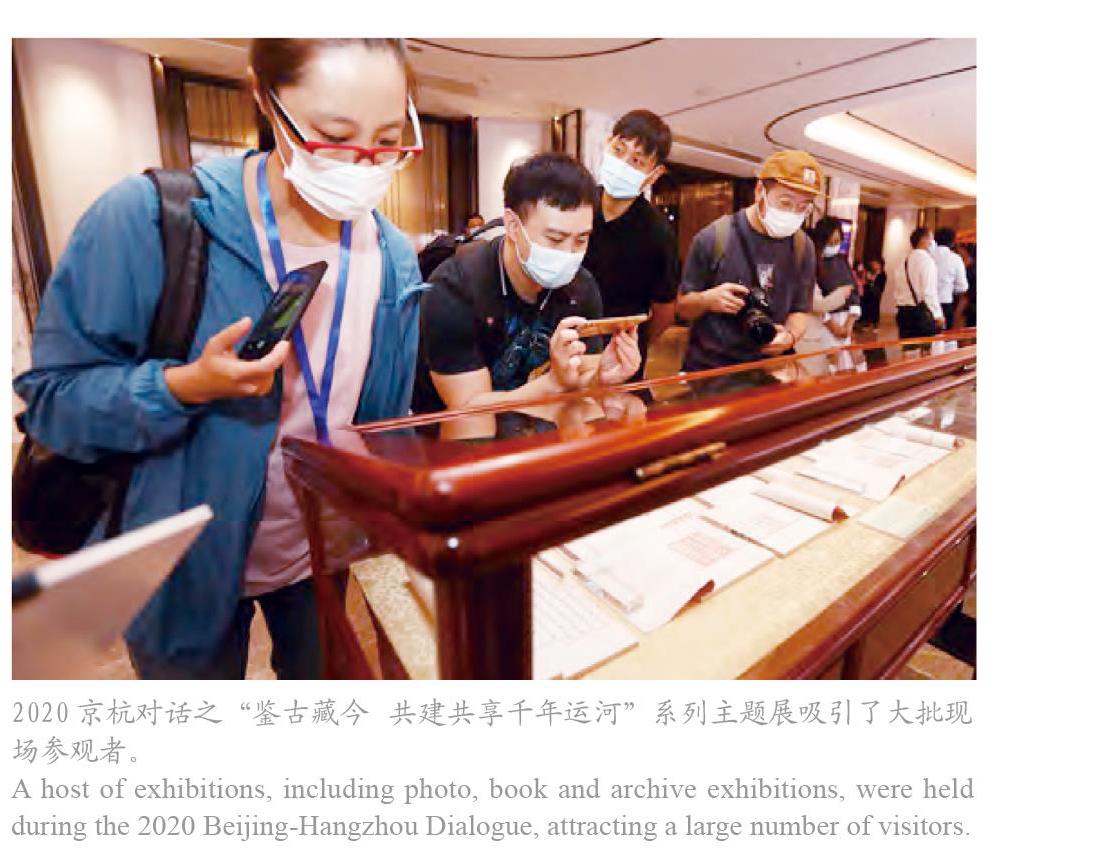遺產風物生生不息
金少策



悠悠運河水流淌兩千多年,滋養著北京、天津、河北、山東、河南、安徽、江蘇、浙江等8省市35座城市。大運河之上,富商巨賈文士名人盡顯風流,江南絲竹民間曲藝精彩紛呈。2014年6月,作為世界上里程最長、最古老、工程最大的人工運河,中國大運河入選世界文化遺產名錄。從河畔人家到數字小鎮,從古橋渡口到文創街區,未變的是兩岸亙古不滅的人間煙火,生生不息。
運河上“飄”來的北京城
“云光水色潞河秋,滿徑槐花感舊游。無恙蒲帆新雨后,一枝塔影認通州。”這是清代詩人王維珍的詩《古塔凌云》,詩中的塔指的就是燃燈塔。沿通州新華大街再向東就到了東關大橋,橋下就是北運河,燃燈佛舍利塔位于通州北端運河西岸,距今已有1300多年歷史。
不久前,北運河通州段迎來全線旅游通航。從漕運碼頭出發,沿著全新的航道前行,不僅可以欣賞旖旎風光,還能感受大運河文化的魅力。行至甘棠船閘,“甘棠魚躍”4個字躍然閘首,浮雕墻上復刻清朝乾隆年間繪制的《潞河督運圖》,再現當年運河河道漕運經濟、商貿往來及民俗文化盛景。
隨船而行,大運河豐富的文化遺產和形態萬千的民風民俗令人印象深刻。
大運河北京段縱貫千年、橫跨七區,物質文化遺產和非物質文化遺產“虛實”結合。有橫跨運河的古橋,有坐落在運河旁的古寺,有通州運河船工號子,還有與運河有關的胡同……
大運河滋養著北京,北京也呵護著這條河。老北京人常說“大運河漂來的北京城”,形象地說明了北京城與大運河密不可分的關系。歷史上的大運河,不僅是供應北京漕糧的經濟補給線,還是影響北京城市氣質的文化交流線。
大運河在五大水系之間架起了一座文化溝通的橋梁,來自各地的文化薈萃于此,造就了海納百川的北京文化,京味文化也由此流向四面八方。
作為北京面塑(中國民間傳統的一種雕塑工藝品)重要代表的“面人湯”面塑,據說創始人湯子博的技藝就是向山東菏澤(曹州)的面塑藝人學的,而這位師傅正是經由運河來到通州謀生;漷縣鎮張莊村的通州運河龍燈會所舞的兩條蛟龍代表“水”的藍色,是運河文化的鮮明印記。
國粹京劇的出現也離不開這條文化水路。清朝乾隆年間,各地戲班齊聚揚州登臺獻藝。演出結束后,各戲班沿運河北上,每經過一個城鎮,就攏船登岸,就地搭臺演出,走一路演一路。一路上不同的戲曲班子同臺演出,互相借鑒。1782年,這支薈萃了不同地方戲曲品種的隊伍到達北京。1790年,“四大徽班”沿運河入京,經過幾十年發展,京劇誕生。就像用水和面一樣,大運河把各個曲種融合在一起。
“漕運晝夜不停,運河號子連天。”這是當年通州大運河鼎盛時期的景象。隨著“運河斷航,船工轉行”,勝景不再,令人惋惜。如今,通州大運河上最后一位老船工、北運河船工號子唯一的非遺傳承人趙慶福老人雖已去世,但通州運河號子并沒有因此而成絕唱。
通州是京杭大運河的北起點,大運河文化的重要節點,當地人對大運河有著深厚的情感,很多老百姓都能講出一段段運河故事。
當年,運河繁忙之時,橋下駁船排列前行,橋上人流穿梭,好不熱鬧。著名的通州八景之一“長橋映月”,就位于此處,“入夜霜清一輪墜,凌寒征鐸去蕭蕭”,便是此景最生動的寫照。
千年運河孕育了銀湖墅
運河穿杭州而過,那延綿數千年的京杭大運河,宛如杭城永不干竭的血脈,促成了這座城市的活力與繁榮。
在京杭大運河南端終點標志——拱宸橋的東側、杭州拱墅區運河文化廣場的南側,坐落著一座講述京杭大運河數千年風雨傳奇的專題博物館——京杭大運河博物館。它一方面是一個全方位、多角度反映和展現運河自然特性、人文精華等各個方面的大型博物館,另一方面又是運河文物、文獻資料等的征集、收藏中心和運河文化的研究和展示中心。它猶如一架“時空穿梭機”,讓進入館內的每一個游客都能穿越回各個時代,瞥一眼運河的歷史身影,了解運河的前世今生。
按序進入館內,首先映入眼簾的便是一艘古樸滄桑的漕運船。這便是博物館的起點——序廳。亮點即在于這一艘擺于正中的漕運船,以及頭頂設計成燦爛星空的天花板與腳下以玻璃鋼鋪設而成的仿真水面,給人一種在運河上徜徉而行、且行且仰望星空的感覺。
京杭大運河博物館共分為“運河的開鑿與變遷”“大運河的功用”“大運河浙江段專題陳列館”“運河文化”四個展廳,從各個層面集中呈現了大運河的歷史、文化與價值。館內陳列之豐富,非一筆所能說盡。
參觀了第三展廳“大運河浙江段專題陳列館”以及第四展廳“運河文化”之后,你心中最深的感想一定是這樣:杭州的發展與演變,絕對離不開大運河的影響。不管是擁有“江南運河第一橋”美譽的拱宸橋,還是“小河貫萬家,街區競物華”的小河直街,還是“北有南新倉,南有富義倉”的富義倉,還是“香火頭道門”的香積寺……都是大運河在杭州留下的深刻印記。
尤其是拱宸橋,就在京杭大運河博物館西面數十米處,走幾步就到。踏上這座滄桑而又堅固如新的古橋,從博物館中所獲知的運河知識,完美地融入到了實物之中,“游與學”在這里成為簡單而愉快的一件事情。
這座建于明崇禎四年(1631)的石拱橋,作為京杭大運河的南端終點所在,不僅養育了一方水土,還曾經形成了一個繁榮的商業區域——“十里銀湖墅”,人煙阜盛,商賈云集。此外,這一帶還形成了有名的“北關夜市”,同樣熱鬧非凡。
運河沿岸盡顯古跡之美
千年運河肇始于江蘇,大運河江蘇段多元化特征明顯,具有遺產類型多樣、數量豐富的特點。其中,列入世界遺產名錄的遺產區核心面積約占全國一半、遺產河段長度約占全國三分之、遺產點數量約占全國40%。
揚州,中國大運河的發軔地,有著“運河長子”的美譽。今年6月16日,中國大運河博物館開館,一票難求。
坐落于揚州運河三灣生態文化公園內的中國大運河博物館,是一座全流域、全時段、全方位展示大運河世界文化遺產價值,以及大運河帶來美好生活的專題博物館。館內,有橋有塔,登塔可俯瞰“三灣抵一壩”的歷史景觀,現有春秋至當代反映運河主題的古籍文獻、書畫、碑刻、陶瓷器、金屬器等各類文物展品1萬多件(套)。
館藏有搬自河南開封附近一段長25.7米、高8米的老汴河剖面,也有整體取自鎮江的唐代船型墓葬,大到來自宜興市的南宋饅頭窯,小到洛陽市文物考古研究院送抵的炭化粟米……博物館堪稱中國大運河的“百科全書”,是江蘇大運河國家文化公園建設中最有分量的一塊“金字招牌”。
如今,從徐州的窯灣鎮歷史街區到淮安清晏園,從揚州瘦西湖到鎮江西津渡古街、從無錫清名橋歷史街區到蘇州盤門等……一街一鎮、一湖一景,都在圍繞遺產點打造國家文化公園建設,一幅古今輝映、人水共生的最美畫卷正在運河沿線徐徐鋪展。
大運河安徽段溝通融匯中原、淮揚、齊魯、楚漢等地域文化,安徽段全長180公里,其中,有水河段約47公里,無水河段約133公里,自河南商丘流入安徽淮北、宿州,進入江蘇宿遷,是隋唐大運河承上啟下、連通東西,貫穿黃河、淮河兩大水系的重要河段之一。
大運河“樞紐天下,臨制四海,舳艫相會,贍給公私”,到南宋末年因淤塞嚴重而幾近斷流。大運河安徽段“扼汴河咽喉,當南北要沖”,屬隋唐大運河通濟渠,是中原文化高地的重要組成部分。
遺產點柳孜運河遺址位于安徽淮北,出土宋代河堤、虹橋遺址、木岸狹河、金代驛道等重要遺跡,是隋唐大運河水工設施遺址的首次發現。通濟渠泗縣段是隋唐大運河現存不多的活態遺址,也是保存最完好、內涵最豐富的河段之一,已成為研究隋唐大運河的重要“活化石”。
大運河遺產山東段,被山東人民親切地譽為“山東的萊茵河”,全長643公里,由北至南依次經過德州、聊城、泰安、濟寧和棗莊5市。山東申遺點段包括南運河德州段、會通河臨清段、會通河陽谷段、會通河南旺樞紐段、小汶河、會通河微山段、中河臺兒莊段等8段運河15處遺產點,總長186公里,遺產區暨文物本體保護區面積為16603公頃,是大運河整體申遺最有力的支撐點段之一。它們歷經元明清三代的開挖與修葺,留存了大量的文物古跡。
大運河遺產名錄
北京市:河道2段,遺產點4個
河道2段:通惠河北京舊城段、通惠河通州段
遺產點4個:玉河故道、澄清上閘(萬寧橋)、澄清下閘(東不壓橋)、什剎海
天津市:河道1段
河道1段:天津三岔口(北、南運河及海河交匯處)
河北省:河道1段,遺產點2個
河道1段:南運河滄州至德州段
遺產點2個:滄州東光連鎮謝家壩、衡水景縣華家口夯土壩
山東省:河道6段,遺產點14個
河道6段:南運河德州段、會通河臨清段、會通河陽谷段、南旺水利樞紐、會通河微山段、中運河臺兒莊段
遺產點14個:臨清運河鈔關、陽谷古閘群(荊門上閘、荊門下閘、阿城上閘、阿城下閘)、東平戴村壩、汶上邢通斗門遺址、汶上徐建口斗門遺址、汶上十里閘、汶上柳林閘、汶上寺前鋪閘、南旺分水龍王廟遺址、汶上運河磚砌河堤、微山縣利建閘
河南省:河道4段,相關遺存3個
河道4段:通濟渠鄭州段、通濟渠商丘南關段、通濟渠商丘夏邑段、永濟渠(衛運河)滑縣浚縣段
相關遺存3個:洛陽含嘉倉遺址、洛陽回洛倉遺址、浚縣黎陽倉遺址
安徽省:河道1段,相關遺存1個,遺產點1個
河道1段:通濟渠泗縣段
相關遺存1個:柳孜運河遺址
遺產點1個:柳孜橋梁遺址
江蘇省:河道6段,相關遺存1個,遺產點21個
河道6段:中運河宿遷段、淮陽運河淮安段、淮陽運河揚州段、江南運河常州城區段、江南運河無錫城區段、江南運河蘇州城區段
相關遺存1個:總督漕運公署遺址
遺產點21個:宿遷龍王廟行宮、清口水利樞紐、淮安雙金閘、淮安清江大閘、淮安洪澤湖大堤、寶應劉堡減水閘、高郵盂城驛、江都邵伯古堤、江都邵伯碼頭、揚州瘦西湖、揚州天寧寺行宮和重寧寺、揚州個園、揚州汪氏小苑、揚州鹽宗廟、揚州盧紹緒宅、無錫清名橋歷史文化街區、蘇州盤門、蘇州寶帶橋、蘇州山塘歷史文化街區、蘇州平江歷史文化街區、吳江運河古纖道
浙江省:河道6段,遺產點13個
河道6段:江南運河南潯段、江南運河嘉興至杭州段、浙東運河蕭山至紹興段、浙東運河上虞至余姚段、浙東運河寧波段、寧波三江口
遺產點13個:南潯古鎮、嘉興長虹橋、嘉興長安閘、杭州富義倉、杭州鳳山水城門遺址、杭州橋西歷史街區、杭州拱宸橋、杭州廣濟橋、西興過塘行碼頭、紹興八字橋、紹興八字橋歷史街區、紹興古纖道、寧波慶安會館
Heritage and Scenery: All the More Lively
By Jin Shaoce
Flowing for over 2,000 years, the Grand Canal has been nourishing the eight provinces and municipalities, as well as the 35 cities it passes through. In June 2014, as the longest, oldest and largest man-made artificial river in the world, it was listed as a UNESCO World Cultural Heritage site. From riverside homes to digital towns, from ancient docks to cultural and creative communities, what has not changed over time is the people on both banks of the river.
Along the Beijing section of the Grand Canal, which spans seven districts for thousands of years, visitors will be able to see ancient bridges striding the canal, ancient temples and pagodas on the banks of the canal, ancient hutongs (small alleys) related to the canal, and listen to the traditional chanting of boatmen on the west bank of the Tongzhou canal...
Not long ago, the Tongzhou section of the Bei (North) Canal in Beijings Tongzhou district was officially opened for tourism navigation. Starting from the Caoyun Dock, travelers can not only enjoy the beautiful scenery, but also feel the charm of the Grand Canal culture.
Indeed, as a bridge of cultural communication between the five major water systems of the Haihe River, the Yellow River, the Huaihe River, the Yangtze River and the Qiantang River, where cultures from all around the nation converge, it is the Grand Canal that has helped created the unique Beijing culture, and that has helped the Beijing culture flow to all directions.
For example, Master Tang Zibo, founding father of Flour Figure Tang, a dough figurine brand created during the Qing dynasty, is said to have learned the craft from a Shandong craftsman who journeyed to Tongzhou via the Grand Canal seeking livelihood opportunities. The Peking Opera, that quintessence of Chinese culture, could also trace its origins to the various performing troupes traveling along the Grand Canal.
At its southern end, the Grand Canal is running through the city of Hangzhou like an artery, providing inexhaustible sources of vitality, strength and prosperity.
On the southern side of the Canal Culture Square in the citys Gongshu district, at the east of Gongchen Bridge, which marks the southern end of the Grand Canal, lies the Grand Jing-Hang Canal Museum. On the one hand, it is a museum that shows the natural characteristics and cultural essence of the Grand Canal in various perspectives; on the other hand, it is also a collection center of cultural relics and documents on the Grand Canal, as well as a research and exhibition center showcasing the canals culture. Like a “time and space machine”, the museum enables every visitor to travel back in time to different periods and learn the history of the canal.
Entering the museum, the first thing visitors see is an ancient and battered Caoyun (tribute grain transport) boat, placed right in the middle of the hall, the starting point of the museum. More notable is that right above the boat, the ceiling is designed to resemble a sky full of stars, and the simulated water surface laid with steel glass underneath lend visitors a feeling of flowing on the canal under the starry sky.
The Grand Jing-Hang Canal Museum is divided into four exhibition halls, including the “Digging and Transformation of the Grand Canal”, the Functions of the Grand Canal”, the “Special Exhibition of the Zhejiang Section of the Grand Canal” and the “Canal Culture”, presenting the history, culture and value of the Grand Canal from all kinds of angles. Indeed, the richness of the exhibitions cant simply be described in a few words.
After visiting the “Special Exhibition of the Zhejiang Section of the Grand Canal” and the “Canal Culture”, most visitors may well conclude: the development of Hangzhou is inseparable from the Grand Canal. The Gongchen Bridge, the Xiaohe Zhijie Historical and Cultural District, the Fuyi Granary or the Xiangji Temple…each of these distinctive Hangzhou symbols came directly from the Grand Canal.
The Gongchen Bridge, in particular, which is only a dozen meters west of the museum, well within the walking distance. Stepping on this ancient and sturdy bridge, the knowledge of the canal gleaned from the museum is perfectly integrated into the “real thing”. Built in the fourth year (1631) during the reign of Emperor Chongzhen of the Ming dynasty (1368-1644), the Gongchen Bridge, a stone arch bridge, is not only the southern terminus of the Jing-Hang Grand Canal, but also was the heart of a bustling commercial center, which was densely populated and crowded with merchants. In addition, the surrounding area used to house the famous “Beiguan night market”, which was equally boisterous.
“Born” in Jiangsu province, it is only natural that the Jiangsu section of the Grand Canal is one of the most diversified in terms of the number and the type of heritage sites. The area of heritage sites inscribed in the World Heritage List accounts for about half of the nations total, the number of heritage sites for about 40% of the nations total, and roughly one-third of the Grand Canal lies in Jiangsu province.
As the birthplace of the Grand Canal, Yangzhou is reputed as “the oldest son of the canal”. When the China Grand Canal Museum opened in the city on June 16, 2021, tickets were immediately sold out. Located in Yangzhou Sanwan Ecological and Cultural Park, the museum is the first modern comprehensive canal theme museum in China that integrates cultural relics protection, scientific research exhibitions and social education. More than 10,000 cultural relics about the canal from the Spring and Autumn Period to the present, such as ancient books, calligraphies and paintings, inscriptions, ceramics, metal ware and so on, are on display.
From a 25.7-meter-long, 8-meter-high cross-section map of the old Bianhe River near Kaifeng city, Henan province, to carbonized millet grains…visitors are supplied with almost all the artefacts on the Grand Canal. The museum is rightly called an “encyclopedia” of the canal, and it is the most important part in Jiangsus efforts to build a Grand Canal National Cultural Park.
With a length of 180 kilometers, the Anhui section of the Grand Canal connects the Central Plains, the Huaiyang region, the Qilu region, the Chuhan region, among other historical and regional cultures. At present, about 133 kilometers of the Anhui section are dry while 47 kilometers are still navigable. Joining Shangqiu in Henan province in the upper reaches and Suqian in Jiangsu province in the lower reaches, the Anhui section was a major part of the Sui-Tang Grand Canal — a part of the Tongji Canal, to be more precise — that helped link the east with the west and that cut through the Yellow River and the Huaihe River.
The Shandong section of the Grand Canal is affectionately called the “Rhine of Shandong” by local people. With a total of 643 kilometers, this section passes through the cities of Dezhou, Liaocheng, Taian, Jining and Zaozhuang from north to south. During the bid for the Grand Canal to become a World Heritage Site, eight canal sections running for 186 kilometers and 15 heritage sites were included. The area that these sections and heritage sites have covered is measured at 16,603 hectares, one of the most significant contributing factors to the Grand Canals successful addition to the World Heritage List.
Inscribed Heritage Items of the Grand Canal
Beijing Municipality: 2 Canal Sections, 4 Heritage Sites
2 Canal Sections: Old Beijing City of the Tonghui Canal, Tongzhou section of the Tonghui Canal)
4 Heritage Sites: Former Canal of Yuhe River, Upper Lock of Chengqing, Lower Lock of Chengqing, Shicha Lake
Tianjing Municipality: 1 Canal Section
1 Canal Section: Tianjin Shanchahou (estuary of Bei Canal, Nan Canal and Haihe River)
Hebei Province: 1 Canal Section, 2 Heritage Sites
1 Canal Section: Cangzhou-Dezhou section of the Nan Canal
2 Heritage Sites: Xiejia Dam in Cangzhou, the well-preserved rammed-earth levée of Huajiakou in Hengshui County
Shandong Province: 6 Canal Sections, 14 Heritage Sites
6 Canal Sections: Dezhou section of the Nan Canal, Linqing section of the Huitong Canal, Yanggu section of the Huitong Canal, Nanwang Complex, Weishan section of the Huitong Canal, Taierzhuang section of the Zhong Canal
14 Heritage Sites: Linqing Customs Post, Yanggu Complex (Upper Lock of Jingmen, Lower Lock of Jingmen, Upper Lock of Echeng, Lower Lock of Echeng), Daicun Dam in Dongping County, Archeological Site of Wenshang Xingtong, Archeological Site of Wenshang Xujiankou Lock, Archeological Site of Wenshang Shili Lock, Archeological Site of Wenshang Liulin Lock, Archeological Site of Wenshang Siqianpu Lock, Archaeological Site of Nanwang Royal Dragon Temple, Archaeological Remains of Wenshang Brick Dyke, Remains of the Lijian Lock in Weishan County
Henan Province: 4 Canal Sections, 3 Archeological Sites
4 Canal Sections: Zhengzhou section of the Tongji Canal, Shangqiu Nanguan section of the Tongji Canal, Shangqiu Xiayi section of the Tongji Canal, Hua-Xun section of the Yongji Canal (or Wei Canal):
3 Archeological Sites: Archaeological Site of the Hanjia Granary, Archaeological Site of the Huiluo Granary, Archaeological Site of the Liyang Granary
Anhui Province: 1 Canal Section, 1 Archeological Site, 1 Heritage Site
1 Canal Section: Si section of the Tongji Canal
1 Archeological Site: Archaeological Site of Liuzi Canal
1 Heritage Site: Archaeological Site of Liuzi Bridge
Jiangsu Province: 6 Canal Sections, 1 Archeological Site, 21 Heritage Sites
6 Canal Sections: Suqian section of the Zhong Canal, Huaian section of the Huaiyang Canal, Yangzhou section of the Huaiyang Canal, Changzhou City section of the Jiangnan Canal, Wuxi City section of the Jiangnan Canal, Suzhou City section of the Jiangnan Canal
1 Archeological Site: Archeological Site of the Caoyun Governors Mansion
21 Heritage Sites: Royal Dragon Temple and Palace in Suqian, Qingkou Hydraulic Complex, Shuangjin Boat Lock in Huaian, Qingjiang Boat Lock in Huaian, Hongze Lake Stone Dyke, Archaeological Site of Luibao Drainage Lock, Yuchen Post in Gaoyou, Remains of the Ancient Shaobo Dyke, Shaobo Docks, Slender West Lake in Yangzhou, Tianning Palace and Temple in Yangzhou, Ge Garden in Yangzhou, Wang Lumens Residence in Yangzhou, Salt Ancestral Temple in Yangzhou, Lu Shaoxus Residence in Yangzhou, Historic Qingming Bridge Quarter in Wuxi, Pan Gate in Suzhou, Shantang Canal Conservation Zone in Suzhou, Historic Pingjiang Quarter in Suzhou, Former Wujiang Towpath in Suzhou
Zhejiang Province: 6 Canal Sections, 13 Heritage Sites
6 Canal Sections: Nanxun section of the Jiangnan Canal, Jiaxing-Hangzhou section of the Jiangnan Canal, Xiaoshan-Shaoxing section of the Eastern Zhejiang Canal, Shangyu-Yuyao section of the Eastern Zhejiang Canal, Ningbo section of Eastern Zhejiang Canal, Ningbo Sanjiangkou
13 Heritage Sites: Nanxun Ancient Town, Changhong Bridge in Jiaxing, Changan Lock in Jaixing, Fuyi Granary in Hangzhou, Archeological Site of Fengshan Hydraulic Gate, Qiaoxi Conservation Area in Hangzhou, Gongchen Bridge in Hangzhou, Guangji Bridge in Hangzhou, Docks of Xixing Distribution Center, Bazi Bridge in Shaoxing, Bazi Bridge Historic Block in Shaoxing, Ancient Towpath in Shaoxing, Qingan Guildhall in Ningbo

